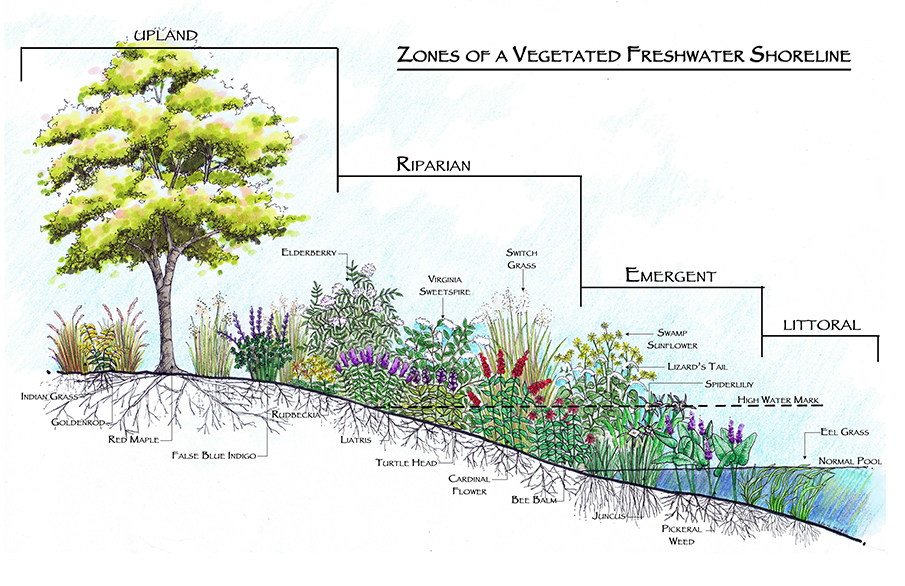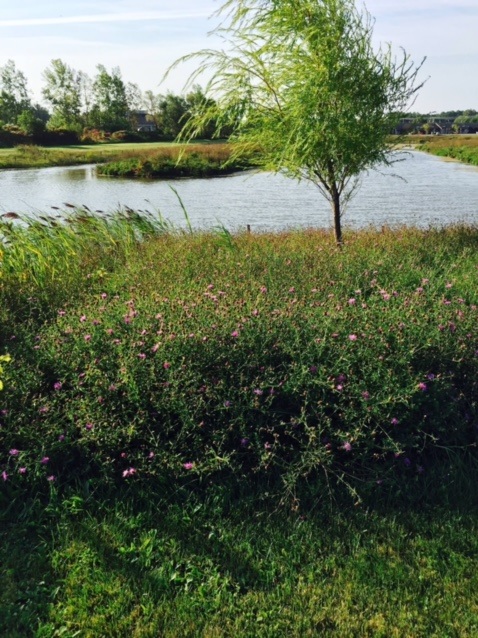Managing Stormwater Ponds
Public Education & Outreach
Stormwater Ponds are extremely important components of our community's stormwater infrastructure.
They are designed to provide two critical services:
- they prevent flooding by supressing surges of stormwater runoff that washes from lawns, buildings, and paced surfaces
- they protect water quality by holding water long enough so that sediment and attached and other pollutants settle to the bottom of the pond before discharge to nearby rivers or beaches.

The primary purpose of all stormwater ponds is to manage stormwater runoff generated by impervious surfaces such as rooftops and pavement. These ponds are not designed to be recreational ponds for fishing or boating, and they are not constructed solely for beautification of the landscape. They are engineered devices, intended to moderate flood surges and reduce stormwater pollution. As with other engineered devices, stormwater ponds require maintenance to prevent them from falling into disrepair. That being said, stormwater ponds that are well maintained may provide additional benefits beyond simply managing stormwater, such as nature watching, boating, and improved property values.
Aquatic plants are essential for a well-balanced pond and healthy aquatic ecosystem.
Aquatic Plants provide many important services identified below.
- oxygenation through photosynthesis
- food and cover for aquatic animals and wildlife
- treatment of excess nutrients and other pollutants
- habitat for beneficial microorganisms
- shoreline stabilization and erosion prevention
- shade and temperature control
- beautification and enhanced land value
Shorelines are home to a unique community of plants, because they are essentially narrow wetlands. Plants that thrive at the water's edge must be able to grow in soils that are permanently saturated and have to survive extended periods underwater. These limiting conditions prevent most of the typical landscape plants from growing well in this zone. As a result, the majority of plants that naturally grow at the water's edge are unfamiliar to most homeowners, and often acquire the label "weed". This is unfortunate because the benefits of cultivating these native plants largely outweigh the negatives, especially along the banks of stormwater ponds. Considering the benefits, it is recommended that wetland plants be protected around stormwater pond shorelines.
Shoreline plants help to:
- prevent erosion and stabilize the bank;
- remove nutrients that contribute to algae growth;
- filter debris and pollutants;
- provide cover and forage for fish, frogs, and song birds;
- shade the water; and
- baffle wind and wave energy; and
- deter waterfowl
Managing Waterfowl in Stormwater Ponds
Although migratory by nature, ducks, geese, and swans often choose to reside in residential stormwater ponds year-round because there are few predatory threats and they can find suitable habitat. As a result, populations of these birds can grow to the extent that they begin to cause significant property damage and become a health concern for themselves, for residents in the community, and for swimmers, surfers, and fishermen using rivers and beaches downstream.
Are there benefits to having waterfowl in a stormwater pond?
Very few. The most significant benefit is aesthetic and a matter of opinion. Having at least some ducks, geese, or swans in a pond does make the pond seem more natural and appealing. Also, waterfowl can be very playful and an enjoyment to watch. Otherwise, waterfowl do not provide any real management services such as controlling weeds or managing pollution. Quite the contrary, concentrated populations of these birds can cause serious property damage and water quality problems in stormwater ponds.
What is so bad about waterfowl in stormwater ponds?
Large aggregations of waterfowl cause significant damage to stormwater ponds. Large groups of ducks, geese, and swans can:
- erode shorelines by trampling and feeding on shoreline plants,
- destroy lawns and gardens,
- introduce invasive weeds that are stuck to their feathers and carried in their digestive tracts,
- deposit large volumes of feces (excrement) that increase algae and weed growth and introduce disease causing pathogens into the water that threaten the health of residents, pets, and the birds themselves,
- make water muddy and cloudy as they sift through the mud for invertebrates,
- become aggressive with children and pets, and
- create unsightly conditions when they molt (shed feathers) and leave feces and feathers in yards, on porches, and on driveways and roads.
How can we reduce the number of waterfowl in our ponds?
Stop feeding them! Although stormwater ponds provide suitable open space and water for ducks and geese, they do not usually provide adequate food. Waterfowl require a diversity of plants and invertebrates for healthy growth, and stormwater ponds do not normally have the appropriate food base to sustain large groups of waterfowl. The primary reason waterfowl aggregate in stormwater ponds is that their diet is being supplemented by humans. Before any other strategy can be employed, a community that is trying to reduce waterfowl numbers MUST curtail all feeding of birds; otherwise, other efforts will be futile.
Also, providing a healthy vegetated shoreline deters waterfowl from congregating. Waterfowl perceive the vegetation as a habitat for predatory threats and avoid.
*Information on managing stormwater ponds has been compiled from original content provided by Benjamin Powell, Clemson Univeristy Cooperative Extension Services
photo credit: Marci Dehl

Blue Heron Park
Pond Riparian Zone
